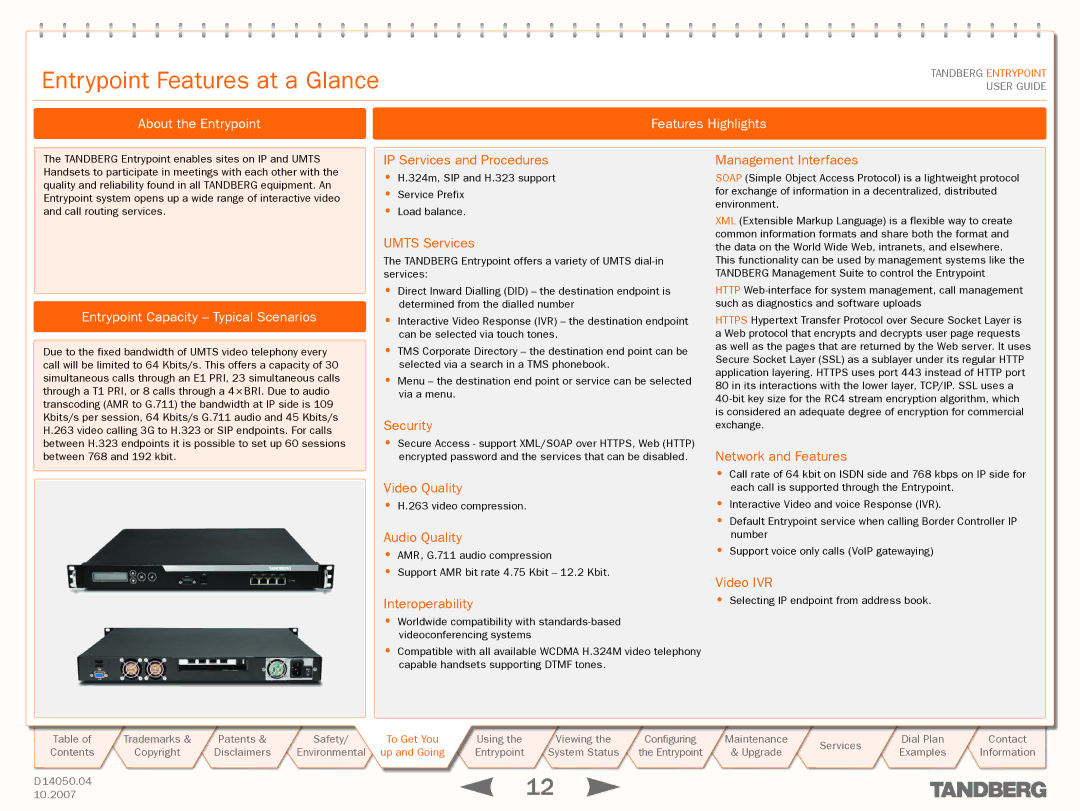
Entrypoint Features at a Glance
TANDBERG ENTRYPOINT USER GUIDE
About the Entrypoint
Features Highlights
The TANDBERG Entrypoint enables sites on IP and UMTS Handsets to participate in meetings with each other with the quality and reliability found in all TANDBERG equipment. An Entrypoint system opens up a wide range of interactive video and call routing services.
Entrypoint Capacity – Typical Scenarios
Due to the fixed bandwidth of UMTS video telephony every call will be limited to 64 Kbits/s. This offers a capacity of 30 simultaneous calls through an E1 PRI, 23 simultaneous calls through a T1 PRI, or 8 calls through a 4 × BRI. Due to audio transcoding (AMR to G.711) the bandwidth at IP side is 109 Kbits/s per session, 64 Kbits/s G.711 audio and 45 Kbits/s H.263 video calling 3G to H.323 or SIP endpoints. For calls between H.323 endpoints it is possible to set up 60 sessions between 768 and 192 kbit.
IP Services and Procedures
•H.324m, SIP and H.323 support
•Service Prefix
•Load balance.
UMTS Services
The TANDBERG Entrypoint offers a variety of UMTS
•Direct Inward Dialling (DID) – the destination endpoint is determined from the dialled number
•Interactive Video Response (IVR) – the destination endpoint can be selected via touch tones.
•TMS Corporate Directory – the destination end point can be selected via a search in a TMS phonebook.
•Menu – the destination end point or service can be selected via a menu.
Security
•Secure Access - support XML/SOAP over HTTPS, Web (HTTP) encrypted password and the services that can be disabled.
Video Quality
•H.263 video compression.
Audio Quality
•AMR, G.711 audio compression
•Support AMR bit rate 4.75 Kbit – 12.2 Kbit.
Interoperability
•Worldwide compatibility with
•Compatible with all available WCDMA H.324M video telephony capable handsets supporting DTMF tones.
Management Interfaces
SOAP (Simple Object Access Protocol) is a lightweight protocol for exchange of information in a decentralized, distributed environment.
XML (Extensible Markup Language) is a flexible way to create common information formats and share both the format and the data on the World Wide Web, intranets, and elsewhere.
This functionality can be used by management systems like the TANDBERG Management Suite to control the Entrypoint
HTTP
HTTPS Hypertext Transfer Protocol over Secure Socket Layer is a Web protocol that encrypts and decrypts user page requests as well as the pages that are returned by the Web server. It uses Secure Socket Layer (SSL) as a sublayer under its regular HTTP application layering. HTTPS uses port 443 instead of HTTP port 80 in its interactions with the lower layer, TCP/IP. SSL uses a
Network and Features
•Call rate of 64 kbit on ISDN side and 768 kbps on IP side for each call is supported through the Entrypoint.
•Interactive Video and voice Response (IVR).
•Default Entrypoint service when calling Border Controller IP number
•Support voice only calls (VoIP gatewaying)
Video IVR
•Selecting IP endpoint from address book.
